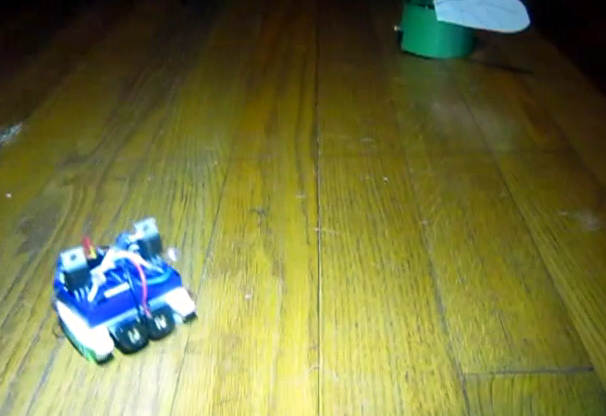
[Ben Finio] designed this project as a way to get kids interested in learning about science and engineering. Is it bad that we just want to build one of our own? It’s a light following bristlebot which in itself is quite simple to build and understand. We think the platform has a lot of potential for leading to other things, like learning about microcontrollers and wireless modules to give it wireless control.
Right now it’s basically two bristlebots combined into one package. The screen capture seen above makes it hard to pick out the two toothbrush heads on either side of a battery pack. The chassis of the build is a blue mini-breadboard. The circuit that makes it follow light is the definition of simple. [Ben] uses two MOSFETs to control two vibration motors mounted on the rear corners of the chassis. The gate of each MOSFET is driven by a voltage divider which includes a photoresistor. When light on one is brighter than the other it causes the bot to turn towards to the brighter sensor. When viewing the project log above make sure to click on the tabs to see all of the available info.
This directional control seems quite good. We’ve also seen other versions which shift the weight of the bot to change direction.
















Granted that I haven’t had a chance to read the article yet, but I seem to be missing from the write up where the science comes into this project. If someone could fill me in that would be excellent.
Wait, so you didn’t even read the page, and you wonder how you could possibly have science in a project where you build something and see how it reacts? You do realize that’s pretty much the *basis* of science, right?
And for a more serious response, there’s a tab on the page (“Make It Your Own”) which offers several experiments that could be performed. But seriously, building *anything* is science. Science is gathering and organizing knowledge in such a way that you can verify it’s correct.
Phototaxis and microcontrollers may still resemble wizardry to some…
microcontroller = science
and an device that is meant to react to light reacting to light, this isn’t really science.
I don’t even see a microcontroller in this project
there is arts and crafts material listed under materials, and that screams science
There’s no microcontroller because it’s using FETs and photodiodes. I’m confused as to how learning how discrete components (which are based only on physics) interact is somehow less science than learning how to program a microcontroller. If anything that seems violently backwards.
My apology I have since read the article and have found that this, by my interpretation, has nothing to do with science, unless you expand the definition of science to some absurd extent.
Engineering quite possibly, entertainment absolutely, educational most likely, but science no.
I get somewhat tired of people mistaking “science” with a situation in which scientific process could be utilized. The rational that *anything* built is science is also very concerning.
To say this is science is to say that everything that is naturally occurring or non naturally occurring is science, provided that you can reference how it is or isn’t like something else. As a definition this is absurd.
Also the comment on the *basis* of science is odd, it appears modelling and science are the same thing based upon your definition, which I can tell you they are not.
When I look at this project I feel this reinforces many of the pseudo-science principles that public schools are known for. “Hey look we put food colouring in a test tube we’re scientists”. As a general rule when science is involved I would expect a statistical analysis of the results to follow.
+1
“Engineering quite possibly”
Freeman Dyson: “A good scientist is a person with original ideas. A good engineer is a person who makes a design that works with as few original ideas as possible.”
The difference between science and engineering is whether you’re trying to do something new or do something that works. The “make it your own” section is doing something new (well, at least, not spelled out, so it’s ‘new’ in that you have to figure out how to do it yourself). That’s science.
“As a general rule when science is involved I would expect a statistical analysis of the results to follow.”
The most important part of the scientific process is not the analysis. Anyone can do the analysis. Nowadays it’s not even people who do the analysis anyway. It’s the first few steps, the “define a question” and “form a hypothesis” step.
Put better, from Isaac Asimov: “The most exciting phrase to hear in science, the one that heralds new discoveries, is not Eureka! (I found it!) but rather, ‘hmm… that’s funny…'”
You make great scientists by having them mess around with stuff and challenging them to think about what’s going on. You make *awful* scientists by forcing them to make silly plots in Excel.
Why don’t you read the article. It’s all there if you’ll actually trouble yourself to look.
how did u make your brisle bot
really all that will help me
sprite_m did the same but he used the sensor from an optical mouse and a small microcontroller.
what is the application of this bristlebots